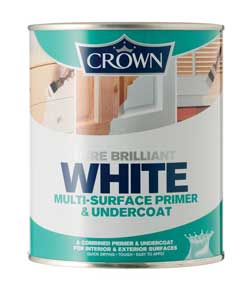




As the weather is improving, I am making plans for my furniture makeover - always have some pieces waiting to be refurbished. I don't have proper studio for such work, particularly for preparations eg. sanding, so I am waiting for warmer days to work outside, in the yard. Another reason is that I like to paint on daily light, as can better notice imperfections and flaws.
In addition to surface preparation, I usually use primer before painting and this post is actually about primer.
Read more about primer after the jump.
What is Primer?
| A primer acts as a barrier coat between original surface and finish coats of paint. Primers bond with and act as a ‘ground’ for subsequent paint application, gilding and varnished treatments. Using a primer before painting furniture is advisable, particularly when any of the old finish is still visible. Priming wood before painting will protect the paint, and protect the wood. As wood is a 'thirsty' substance, it is easy for water to get absorbed into the grain itself. Often the paint will begin to pucker and peel if the wood isn’t dry, making it necessary to scrape and start over. Primer creates a watertight seals between the two and ensures the paint has a smooth and adhesive surface with which to bond.The primer will also ensure the topcoat does not yellow and will enhance its performance by making it tough and durable. Of course, primer is recommended for a variety of other materials as well. In concrete and drywall, for instance, it will seal the surface and create a solid bond, for metals – especially those prone to rust – a paint primer can protect the surface itself and keep moisture locked out. Plastics too can benefit from a coat of paint primer, particularly if they are porous in nature or you are putting a light color over a darker one. Don't forget, before applying the primer, surface must be properly prepared - sanded, cleaned, flaws corrected (but this will be part of some future posts). As I usually refurbish old pieces, primer is 'must' for me. This drawer was in awful condition when I got it. After pealing old paint coats, repairing the surface and sanding, sanding, sanding, I put first primer coat. As it is white, it was easy to notice imperfections still to be corrected - meaning put filler or sanding, sanding again. You can see my favourite tool - orbital electric sander, it is amazing how useful it is. Second layer of primer was necessary and this time I was happy with the result. Next steps are painting - haven't made yet final decision how to do it. |
Which primer to pick out?
Nowdays there are number of various primer products available and sometimes is challenge to pick up the best fot the certain problem.
Choice: oil or watter based primer?
Acrylic primers are commonly used for interior and exterior surfaces, furniture and objects. Its quick drying time allows for quicker final results and the tools can be easily cleaned under running water (that's why I use them whenever I can). Not recommended for metal, glass or other non-porous substrates.
For high traffic zones or heavily used areas oil based primers are recommended.
Oil / alkyd primers are excellent for exterior surfaces, wood and metal. Best suited for a base to oil based paints, the use of acrylic paint over oil-based primers is also acceptable.
Note:
Oil and water based paint can be applied pver oil-base primers. The reverse is not true; it is generally a rule of thumb never to apply oil-based paints and varnishes over water-based primers.
Note:
Oil and water based paint can be applied pver oil-base primers. The reverse is not true; it is generally a rule of thumb never to apply oil-based paints and varnishes over water-based primers.
Stain-blocking primer
Stain blocking primers can be oil or water based and are good choice if stains are bleeding right through primer or paint no matter hoe many coats applied. The same goesfor odors like smoke from fires or cigarettes.Tinted primerWhen you change from a light color to dark (or vice versa), sometimes it takes number of coats ofo paint to hide the existing paint color. Tinting primer gray or a color similar to finish paint reduces the number of necessary topcoats. Not all primers can be tinted darker, so make sure to choose the right one. Some primers already come pre-tinted.Transparent primerIn some cases, when you'd like to apply transparent topcoat, transparent primer is the best choise. |




No comments:
Post a Comment